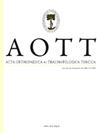全膝关节置换术治疗终末期亲血性关节病的中期临床结果
IF 1.1
4区 医学
Q3 ORTHOPEDICS
引用次数: 1
摘要
目的:本研究旨在评估全膝关节置换术(TKA)治疗终末期血友病关节病的中期临床效果。方法:对11例(15膝)膝关节强直性TKA患者进行回顾性分析。所有患者均进行TKA,无需额外的手术干预,如后囊松解、腘绳肌松解、滑膜切开术、VY股四头肌成形术或胫骨结节截骨。所有患者在随访时均进行了临床和放射学结果评估。使用膝关节学会评分和视觉模拟量表评估功能评估和疼痛状态。结果:手术时的平均年龄为40.8±11.8岁(范围 = 30-64岁)。平均随访时间为51.2±20.6个月(范围 = 24-95)。平均屈曲挛缩度从17.6±11.3度显著降低到1.7±2.8度,平均最大屈曲度从55.6±20.5度显著增加到109.2±16.2度(P<0.001)。平均膝关节社会评分从术前的22.7±2.4分增加到最后一次随访时的87.8±3.8分(P<0.001)。凝血因子消耗和输血的平均费用占总费用的78%。结论:TKA是治疗终末期膝关节亲血性关节病的一种有效方法,可减轻疼痛,改善活动范围和生活质量。证据级别:IV级,治疗研究本文章由计算机程序翻译,如有差异,请以英文原文为准。
The mid-term clinical outcomes of total knee arthroplasty in the management of end-stage hemophilic arthropathy
Objective: This study aimed to evaluate the mid-term clinical outcomes of total knee arthroplasty (TKA) in the management of end-stage hemophilic arthropathy. Methods: Eleven patients (15 knees) undergoing TKA with stiff knees were retrospectively evaluated. TKA was performed in all patients without additional surgical interventions such as posterior capsular release, hamstring release, synovectomy, VY quadricepsplasty, or tibial tubercle osteotomy. All patients were evaluated for clinical and radiological results at follow-ups. Functional evaluation and pain status were assessed using the Knee Society Score and Visual Analogue Scale. Results: The mean age at the time of operation was 40.8 ± 11.8 years (range = 30–64 years). The mean follow-up was 51.2 ± 20.6 months (range = 24–95). The mean flexion contracture significantly decreased from 17.6 ± 11.3 to 1.7 ± 2.8 degrees, and the mean maximum flexion increased dramatically from 55.6 ± 20.5 to 109.2 ± 16.2 degrees (P < 0.001). Statistical significant improvement in flexion and flexion contracture degrees continued up to the postoperatively 18 months. The mean Knee Society Score increased from 22.7 ± 2.4 points preoperatively to 87.8 ± 3.8 points at the last follow-up (P < 0.001). The mean cost of coagulation factor consumption and blood transfusion accounted for 78% of the total cost. Conclusion: This study has shown that TKA is an effective treatment for relieving pain and improving both ranges of motion and quality of life in managing end-stage hemophilic arthropathy of the knee joint. Level of Evidence: Level IV, Therapeutic Study
求助全文
通过发布文献求助,成功后即可免费获取论文全文。
去求助
来源期刊

Acta orthopaedica et traumatologica turcica
ORTHOPEDICS-
CiteScore
2.00
自引率
0.00%
发文量
66
审稿时长
>12 weeks
期刊介绍:
Acta Orthopaedica et Traumatologica Turcica (AOTT) is an international, scientific, open access periodical published in accordance with independent, unbiased, and double-blinded peer-review principles. The journal is the official publication of the Turkish Association of Orthopaedics and Traumatology, and Turkish Society of Orthopaedics and Traumatology. It is published bimonthly in January, March, May, July, September, and November. The publication language of the journal is English.
The aim of the journal is to publish original studies of the highest scientific and clinical value in orthopedics, traumatology, and related disciplines. The scope of the journal includes but not limited to diagnostic, treatment, and prevention methods related to orthopedics and traumatology. Acta Orthopaedica et Traumatologica Turcica publishes clinical and basic research articles, case reports, personal clinical and technical notes, systematic reviews and meta-analyses and letters to the Editor. Proceedings of scientific meetings are also considered for publication.
The target audience of the journal includes healthcare professionals, physicians, and researchers who are interested or working in orthopedics and traumatology field, and related disciplines.
 求助内容:
求助内容: 应助结果提醒方式:
应助结果提醒方式:


